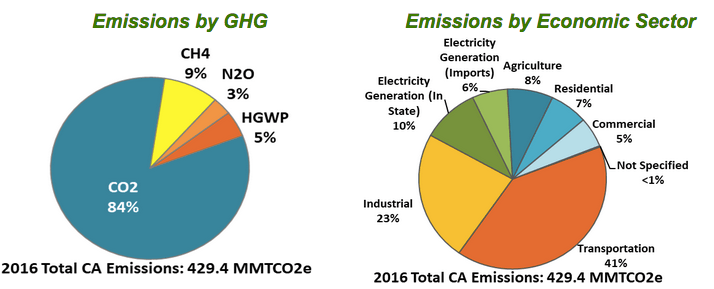Note: GJEL Accident Attorneys regularly sponsors coverage on Streetsblog San Francisco and Streetsblog California. Unless noted in the story, GJEL Accident Attorneys is not consulted for the content or editorial direction of the sponsored content.
The California Air Resources Board (ARB) released its 2018 Greenhouse Gas Emissions inventory today, and according to its number crunching the state is reaching its first set of climate goals. The California Global Warming Solutions Act, A.B. 32, required state agencies to figure out a way to reduce greenhouse gas emissions to 1990 levels by 2020.
This latest data—from 2016, because of long delays in collecting and analyzing it—show that California's greenhouse gas emissions were a little below 1990 levels in 2016, which was a three percent drop from 2015.
ARB executive director Richard Corey, quoted in the press release, reminds everyone that emission numbers can change a lot, “depending on the weather and other factors.” But the data show that, at least in the electricity sector, state policies “are working to incentivize GHG-free energy sources and ensure the state remains on track to meet its climate targets in 2020 and beyond.”
“The numbers that will really count toward the 2020 target will be those reported in 2020,” says ARB Communications Director Dave Clegern. “However, this does send a very strong, positive signal that the target can be achieved and that California’s climate programs are working.”
The largest decline in emissions came from the electricity sector, which showed a sixteen percent drop in emissions in 2016. Electricity was the first major energy sector subject to the state's cap-and-trade program, which caps emissions and charges companies for polluting. California's Renewables Portfolio Standard also requires providers to increase the percentage of renewable sources over time, and that led to increased use of solar and hydroelectric power from both in- and out-of-state sources.
Hydroelectric sources grew 39 percent in 2016, in part because of that year's abundant rainfall—thus the weather-dependent emissions comment above.
This is all pretty good news, especially when considering that at the same time this was happening, the state's economy was growing—showing that it really is possible to reduce emissions without everyone having to go barefoot and live on gruel. In fact, the inventory shows that per capita emissions are about half the national average, and California is producing twice as many goods and services for the same amount of greenhouse gas emissions as the rest of the nation.
But a close look at the numbers shows there is a lot of work still to be done. For one thing, emissions from the transportation sector went up, not down, and there doesn't seem to be any sign of that trend changing any time soon. That's a big problem because transportation emissions make up more than forty percent of overall greenhouse gas emissions in the state. And that takes into account the increases in cleaner and renewable fuel sources.
In addition, the 2020 targets were relatively easy. S.B. 32, the follow-up to the Global Warming Solutions Act, sets much stricter targets for the future: another forty percent below 1990 levels by 2030. Those will be harder to meet, especially given current policies and funding mechanisms, and the fight it has been to get to this point.
Also important to keep in mind is that CARB's inventory takes into account human-caused emissions—things that humans can change through regulation, behavioral changes, and technology. It does not include emissions from things like wildfire, which although caused in part by human-caused changes in the climate, cannot be regulated.
Indications are that the cap-and-trade program, the low-carbon fuel standard program, and the emphasis on renewables are helping reduce emissions. “The latest greenhouse gas figures from ARB affirm the tremendous value of the statewide package for pollution reductions that includes cornerstone cap-and-trade and low carbon fuel standard programs,” said Timothy O'Connor of the Environmental Defense Fund.
“At the same time, the figures show there is much more work to be done to further rein in transportation emissions and create even deeper reductions that are needed to achieve a low-carbon economy.”






